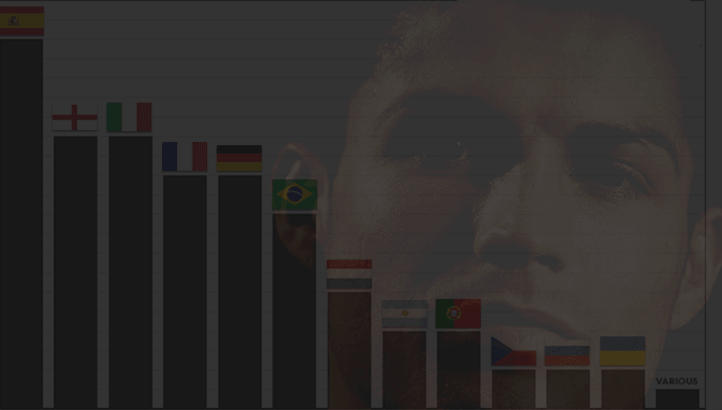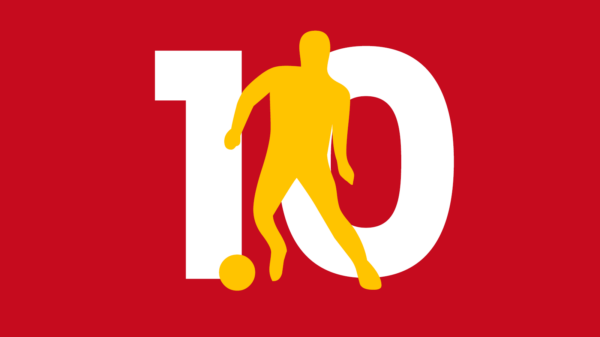Often the players playing for the biggest clubs in the world, are the ones that are ‘officially’ recognised as the best individuals in the sport. It might seem like a lazy bit of accreditation but it’s actually a fair assessment of the beautiful game. The best, play for the best. And while a lot of their development, and ability is honed at these clubs – given the top quality facilities and resources, it isn’t where their core football skills are established. Consult any coach or professional and they’ll explain how a footballers’ initial years can determine his future career path. Academies start it off, while the initial professional senior football years engrave skills and set the tone for the next decade or so.
It’s highly unlikely that a player who at some point in his career when he reaches his peak and stands out in a competitive market in an elite class of individuals, would not have stood out more or less equally in the early part of his career. Recognising this is a whole different matter with the burden to do so on the viewer rather than the individual.
UPDATE: This article featured in Goalden Times’ Word Ball 2015 in the Analytical category.
In the vastly popular sport of football, opinions (and differences thereof) are abundant, to determine who ‘the best’ are can lead to a heated debate with no clear outcome. We are blessed then to be presented with a 23 man shortlist every year of the Ballon D’Or, the highest individual honour in the beautiful game. While this too leads to clambering discussions largely led by a clear bias, it serves as a standard tool of reference for ‘the best’.
The purpose of this analysis is to determine which clubs primarily succeed over an above others in creating the best players at the first stage , which clubs are successful in establishing the primary abilities of a player in professional football and which clubs have the ultimate success in realising a players true potential/ability in the lead up to their peak.
THINGS TO REMEMBER & KEY TERMS
Players that have been considered: To conduct this analysis it would have to be determined who the ‘best’ players are. Rather than tainting this piece with personal bias and opinion, the annual 23-man Ballon D’Or shortlist has been used. Over the years, certain players have been shortlisted but haven’t received a single vote; in such a circumstance, the player has not been considered for the analysis.
Academy Phase: Years prior to senior first team football. In the instance where a player has played for multiple academies, the latest one played in and/or the one with the most perceived impact on the players’ career is considered. (Eg: Cesc Fabregas has been considered to be a Barcelona product and not an Arsenal one, despite spending a few months in the London club’s academy).
Development Phase: The initial years of first-team football when the player is aged 19-22. It is what we consider the most crucial stage in the development of a player (and also the age criteria for most of our Talent Radar features). In certain cases players may have played for two or more different clubs in this phase. Again, the one with the most perceived impact is considered. (Eg: Thibaut Courtois has played for Genk, Atletico Madrid and now Chelsea in that period; he’s considered a representative of Atletico in his development phase)
Lead-up Phase: This is basically the entire phase of a players’ career leading up to his Ballon D’Or nomination. So it includes every club he has played for in senior football, including the club he was at while being nominated. (Eg: For Zlatan Ibrahimovic every club he has played for professionally from Malmo to Paris Saint-Germain will be considered for evaluation).
Time Period: As you will see below, evaluation has been done for two separate time periods to get a general idea about the state of football over the last decade and a more relevant period which takes into consideration the changes in the sport.
Analysis has thus been done for i) Academy Phase, ii) Development Phase & iii) Lead-Up Phase for the period 2005-2014 (last 10 years) and for 2010-2014 (more relevant last 5 years).
Graphical Representation: All graphs display players/clubs with only 2 or more representatives; clubs with one representative have been displayed on the ‘various’ bar as there are just far too many and failure to have more than one representative doesn’t show enough consistency to warrant recognition.
2005-2014 PERIOD
ACADEMY PHASE

GRAPH 1
Unsurprisingly the club with the most players to have come through from it’s academy and gone on to be shortlisted over the last 10 years are Spanish giants Barcelona. The Catalan club have had 8 representatives in the set parameters, 5 of which still play for the club (Andres Iniesta, Gerard Pique, Lionel Messi, Sergio Busquets & Xavi Hernandez), 1 is currently at another club (Cesc Fabregas), and 2 have retired (Carles Puyol and Luis Garcia, the latter is one who some may have forgotten has come through Barca’s youth system though not making a significant impact at senior level with the club. His Ballon D’Or nomination came in 2005 while playing for Liverpool).
Bayern Munich is the next highest placed club with 4 representatives (Bastian Schweinsteiger, Philipp Lahm, Thomas Müller and Toni Kroos), most of whom have earned their nomination in more recent seasons.
The club to have ranked high up and personally surprised in doing so, was German side Schalke which had 3 representatives; more interesting is the fact that two of them were goalkeepers (the only club to hold this particular record). Jens Lehmann, Manuel Neuer and Mesut Özil are all players who have made their way through Gelsenkirchen. Santos equals Schalke’s numbers with Diego Ribas, Neymar & Robinho their representatives.
But what is the most thought provoking revelation from the data above is that prestigious and/or financially well backed clubs proud of their history and youth setup (Manchester United, Liverpool, Boca Juniors etc) have as many academy representatives to be shortlisted for the Ballon D’Or over the 10 year period as the little known academy in Accra, Liberty Professionals. With Asamoah Gyan and Michael Essien being their proud representatives, the Ghanaian academy have managed to compete with some of the more famed academies with their track record.

GRAPH 2
The graphic above takes a look at which country had the most academies to have Ballon D’Or representatives from 2005-2014. Note that this is NOT the nationality of the players, but the location of the academy that is being represented.
Brazil stands out clear for the 10 year period with 13 different academies/clubs. These 13 include some of the more established names of Brazilian football in Santos, Sao Paulo & Gremio etc, but also the lesser known Barcelona Esportivo Capela where Diego Costa came out of. It’s hard to state what impact the academy had on the Spanish striker because his initial years were average at best or below, having only risen in the last 2-3 seasons. But we’ll give the benefit of doubt to Barcelona EC as we firmly believe in the impact academies are capable of.
Lyon leads the way in France with 2 representatives as the European country is second on our analysis after Brazil. The seven time French champions got Frederic Kanoute and Karim Benzema going while all other clubs from the country had a solitary representative which includes US Boulogne (Franck Ribery) and FC Melun (Claude Makelele).
10 academies feature from Italy with 10 different players. Interestingly traditionally mega clubs Juventus and Inter Milan don’t have a single academy graduate to have excelled at the World stage while clubs like Como (Gianluca Zambrotta), Lumezzane (Mario Balotelli) and Modena (Luca Toni), all feature.
Special mentions also to Colombia’s Envigaldo (James Rodriguez) & Lanceros (Radamel Falcao), Czech Republic’s Dukla Prague (Pavel Nedved) & Viktoria Plzen (Petr Cech) and Uruguay’s Danubio (Edinson Cavani) & Nacional (Luis Suarez) to have dual representatives.

GRAPH 3
The above graph is just a representation of the number of players to have come through from academies in countries across the World. Brazil leads the way here as well with 16 players including the likes of Kaka, Rogerio Ceni, Julio Cesar, Maicon etc.
Spain, France, Germany & Italy are in close proximity while English academies certainly didn’t impress with majority of the 8 representatives being players well into the latter stages of their careers or already retired (Frank Lampard, Jamie Carragher etc). Subsequent graphs in this piece will show how England has further lost out more recently. Portugal’s two representatives are both from the same club (Cristiano Ronaldo & Nani of Sporting CP), which is something both Benfica and Porto should be worried about despite being more successful in recent seasons.
Argentina are tied with Netherlands and far below their South American rivals Brazil, but as Graph 13 later represents, you’ll see why the former is actually in a better state.
DEVELOPMENT PHASE
As previously mentioned, this according to us is what truly sets up a players’ career, defines his future and ideally develops the individual. It’s the phase between youth football and established professional, though the latter is sometimes no different than the development phase for some.
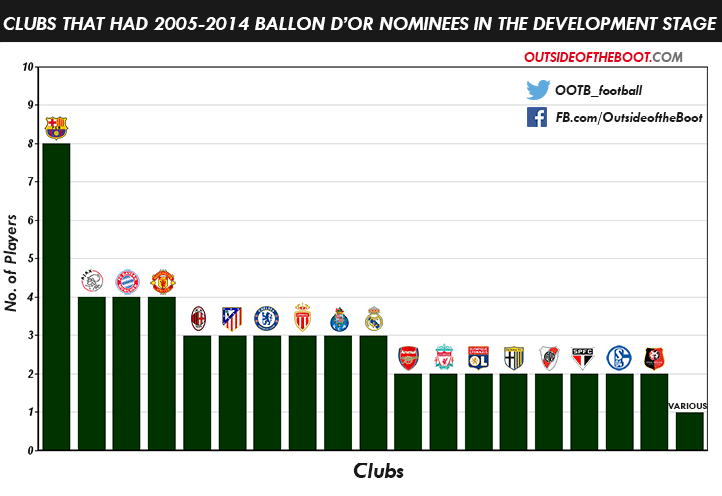
GRAPH 4
The players that are at these clubs in the development phase have either come through their own academy (Wesley Sneijder at Ajax), bought for a significant fee (Eden Hazard at Chelsea) or bought for a rather minimal fee (James Rodriguez at Porto).
Again Barcelona leads the way in this regard with the same players as the academy phase with the exception of Fabregas who at this point left for Arsenal, while Neymar came in from Santos.
A special mention must go out to both AS Monaco and Stade de Rennes. Both clubs aren’t mentioned in the same breath as some of the other clubs in Graph 4 above, but both have done well to develop world-class individuals. AS Monaco are represented by Emmanuel Adebayor, Eric Abidal and Thierry Henry while Rennes had Luis Fabiano & Petr Cech in their ranks. Many would not have seen it then and most may not see it now either, but the likes of Yannick-Ferreira Carrasco and Paul-Georges Ntep (for example) could potentially turn out like their predecessors. Speculation of course.
Ajax have had a good blend of academy graduates and an excellent scouting system for their four representatives. Edwin Van Ser Sar and Wesley Sneijder represent their academy while Luis Suarez and Zlatan Ibrahimovic both were products of smart scouting. Manchester United’s four players only include one from their academy (Ryan Giggs), with the rest (Cristiano Ronaldo, Nani & Wayne Rooney) picked up at a young age.
FC Porto’s three representatives were another reminder of how their efficient scouting system keeps them competing consistently. Diego Ribas, James Rodriguez and Thiago Silva all played their developmental years at the Portuguese outfit, though the defender in that lot only turned out for the B team.

GRAPH 5
Italy over takes Brazil in terms of number of clubs that had players in the development stage over the 10 year period. These include AC Milan (Gennaro Gattuso, Paulo Maldini & Yoann Gourcuff), Parma (with Adriano & Gianluigi Buffon), Napoli (Fabio Cannavaro) and the smaller Piacenza (Pippo Inzaghi).
Brazilian representatives include smaller clubs in Alverca (Deco) and Rio Brance (Marcos Senna) which go on to highlight the wide-spread effect of Brazilian football which isn’t restricted to only certain clubs.
Ukraine makes a rather surprising entry at this level, led of course by Andriy Shevchenko’s Dynamo Kyiv and the much less popular side of Metalurh Donetsk that boasted of a certain Yaya Toure during his development stage. Their Eastern European neighbours, Russia have two representatives as well in Spartak Moscow (Nemanja Vidic) and Zenit St. Petersburg (Andriy Arshavin).
All 7 of England’s representatives are established top-flight clubs while Germany’s 8 include Chemnitzer (Michael Ballack) and Homburg (Miroslav Klose). Who would have thought, eh?

GRAPH 6
This graphic only goes on to highlight the falling Brazilian football, which you’ll continue to witness in subsequent graphics as well.
Spain is the clear leader here, helped by the fact that in addition to Barcelona’s existing numbers, both Madrid clubs added well. Atletico Madrid had Fernando Torres, Sergio Aguero and Thibaut Courtois at the peak of their developmental levels, while the white of Real were graced by the presence of Clarence Seedorf, Iker Casillas and Sergio Ramos.
England and Italy are joint-second, both of whom enjoyed their fair share of domination a couple of years back which isn’t quite the same in present times.
LEAD-UP PHASE

GRAPH 7
Not meant to dwell too much into this graphic but it displays clubs that at some point possessed players in their first team in the years leading up to that players’ Ballon D’Or nomination or during it. So Zlatan Ibrahimovic for example, is represented 7 times for the 7 different clubs he has played for in the lead up to his recent nomination with PSG (i.e, Malmo, Ajax, Juventus, Inter Milan, Barcelona, AC Milan, PSG).
We believe that every club a player plays for has some impact in further developing his abilities, either physically, tactically or in some form. Barcelona and Real Madrid completely dominate in that regard having had 21 and 20 different players respectively who either played for them while being shortlised for the Ballon D’Or, or did play some part in the years leading up to it. While most of the 41 combined players between the Spanish giants are the obvious names, it may be easy to forget that the likes of Juan Roman Riquelme also count as representatives.
AS Monaco impress again, having had 7 different players play for them within the set parameters, equalling the numbers displayed by more established clubs like Arsenal & Liverpool while exceeding the representatives of Paris Saint-Germain, Manchester City, Borussia Dortmund, Ajax. Emmanuel Adebayor, Eric Abidal, James Rodriguez, Maicon, Radamel Falcao, Thierry Henry and Yaya Toure all played for some period at the French club.
The tally’s of the Italian clubs – Juventus (13), AC Milan (12) & Inter Milan (12) are a bit deceiving and their numbers speak better volumes in subsequent graphs. The numbers above include Jens Lehmann’s brief stint at AC Milan, Pavel Nedved’s excellent period at Juventus (which is a bit irrelevant in present times) and Andrea Pirlo’s forgotten stint at Inter Milan.
2010-2014 PERIOD
The period selected here is more relevant to the present time and might give you a suggestion of where to look for world football’s next big star. The last 5 years have showcased changing times in football when compared to the past 10 years, which the graphs below will clearly represent.
ACADEMY PHASE

GRAPH 8
Barcelona’s domination doesn’t come as a surprise, while Bayern Munich too have firmly cemented their reputation of developing football players. It’s interesting to see though how both these clubs move ahead from here, and how different this graphic could be in about 5 years time. Both these clubs, while producing quality individuals and occasionally giving them the opportunities as well, are competing at the highest level of football as “super clubs”. The temptation of going out and securing more established stars as opposed to providing opportunities may only grow as the playing field gets all the more competitive.
Independiente (Diego Forlan & Sergio Aguero), Schalke (Manuel Neuer & Mesut Özil) and Sporting CP (Cristiano Ronaldo & Nani) also have more than one representative.
Interestingly again, those with only one representative (falling under the ‘Various’ bar in the graph above) include some of the ‘smaller’ academies/clubs like ASEC Mimomas (Yaya Toure), Kadji Sports Academy (Samuel Eto’o), Boulogne (Franck Ribery), Levallois (Didier Drogba), Legia Warsaw (Robert Lewandowski), Rosario Central (Angel Di Maria) Genk (Thibaut Courtois) etc. That’s the same number as established clubs like Real Madrid & Manchester United, renowned academies like Ajax & Southampton while being more than clubs such as Arsenal, Atletico Madrid, Juventus, Liverpool, Manchester City, Paris Saint-Germain etc, all of whom don’t have a single academy representative shortlisted for the Ballon D’Or in the last 5 years.
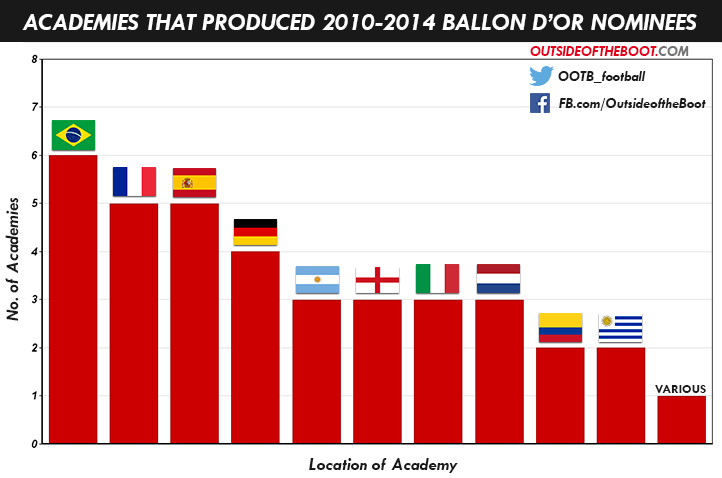
GRAPH 9
Brazil still leads the way in terms of the number of different academies to have representatives. Bahia, Barcelona EC, Cruzeiro, Fluminense, Grajau & Santos are the 6 flying Brazilian colours.
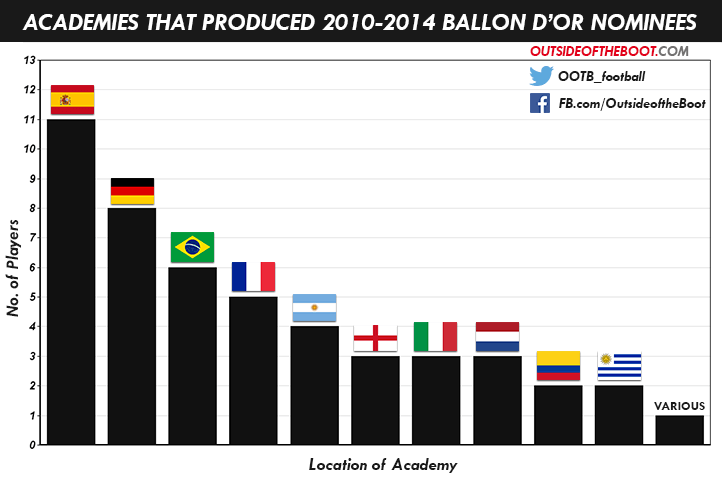
GRAPH 10
As you can see, Spain leads the way in terms of total number of players in the last 5 years, taking over from Brazil that led the 10 year period, with the South American nation dropping to third below Germany too.
England’s representatives are in the form of Gareth Bale (Southampton), Paul Pogba (Manchester United) and Wayne Rooney (Everton) of which only one of them remains in the country and none are at the first team of the academy they came through. A worrying trend in English football.
Italy has seen a fall as well in the last 5 years but it manages to keep up with both England and Netherlands, the latter of which is often perceived to be the breeding ground of talent. Having said that though, two of Italy’s three representatives are Brescia and Parma, who produced Andrea Pirlo and Gianluigi Buffon respectively. Fair to say that their academy phase was quite a while back. In recent years Italy has failed to really produce an impressive talent with Mario Balotelli being the other representative. The ex-Lumezzane youngster is currently facing his fair share of troubles in his senior career.
DEVELOPMENT PHASE

GRAPH 11
Here’s where it gets interesting again. No changes in terms of the top clubs for representatives at the development phase in the last five years. Manchester United pulls level with Ajax, having signed both the Sporting CP academy graduates which were displayed in Graph 8. Two smart transfers in Sergio Aguero and the loan move of Thibaut Courtois represent Atletico Madrid. Real Madrid’s only academy graduate in Iker Casillas is joined by Sergio Ramos to represent the 2014-15 Champions League winners.
Mentions must go out to Albacete (Diego Costa), Le Mans (Didier Drogba), Sporting Gijon (David Villa), Udinese (Asamoah Gyan) & Werder Bremen (Miroslav Klose) for managing representatives in the ‘various’ bar in Graph 11.

GRAPH 12
The graph above shows you how the likes of Argentina, Brazil, Netherlands & Portugal lose the players they develop fairly early on, England being the primary beneficiaries. For all of Italian football’s criticisms, they’re again hanging in there with more reputed leagues of England and Germany.

GRAPH 13
Spain dominates in terms of the number of players with a whooping 16, double that of their closes rivals. The small bar towards the end that represents Brazil is the worry, giving suggestions of potential stagnation. Brazilian clubs constantly lose players to European clubs at a younger age, with most of the stand-out performers already having moved by the time they reach their development stage.

GRAPH 14 // (EDIT: Bayern Munich should be in there, tied at #3 with Inter Milan)
Real Madrid and Barcelona dominate again when it comes to players plying their trade with the club during or in the lead up to their Ballon D’Or shortlisting. Interestingly, though not surprising, is the fact that of the 16 Real Madrid players displayed in Graph 14, only 1 is a product of their academy (Iker Casillas) and only 1 more was with them at the development stage (Sergio Ramos). This gives you a suggestion of their transfer policy.
Inter Milan showcase an impressive number as well, given the fact that they were at the top of footballing world not too long ago, but again, not a single representative of theirs came through from the academy. This is the biggest problem in Italian football, until their academy system is developed to the point where they don’t depend on buying players in an existing financial crisis, they won’t be able to rise to where they were.
The likes of Werder Bremen (Ozil & Klose), Real Zaragoza (Villa & Pique), Gronigen (Suarez & Robben) all feature, which is quite surprising. Imagine a current 21 year old attacker playing for Gronigen potentially becoming one of the best players in the world in 5-6 years time.
In the current football climate where long-term strategies are becoming paramount, the trends displayed above will only continue unless steps are taken. Clubs like Barcelona & Bayern Munich have bright futures with the development coming through their academies. One has to wonder if Real Madrid will ever alter their strategy to give their academy graduates more opportunities, given that they look elsewhere when a deficiency appears in the side. It’s not a healthy strategy, but it’s gotten them through.
English clubs aren’t in their most prosperous era, but the likes of Manchester City taking steps to open a new academy is the right way to move forward. General enthusiasts look to France and immediately think of the riches and Paris Saint-Germain but AS Monaco have done well in producing players while a whole host of lesser known clubs continue to churn out talent.
The ability of Dutch academies to produce may be a myth. While we firmly believe that they, along with France, have the best youth setups and potentially the brightest futures, the data of the previous years doesn’t show good reading for Oranje.
Clubs may be better suited to investing in efficient scouting systems to look at players in Africa and South America rather than spending millions on established stars. One has to wonder what future football clubs have as a business when the best and most successful clubs aren’t necessarily producing the best players but rather depending on purchases from elsewhere.
The future of football is depended on the numerous obscure academies across the world; the benefits though, are not always reaped by them.
Written by Sami Faizullah




















































